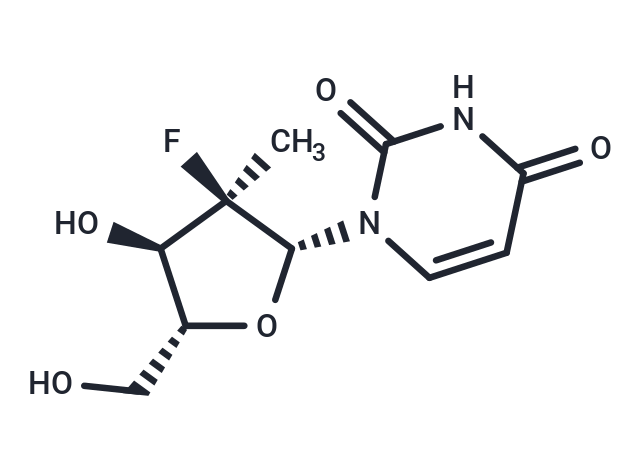Shopping Cart
- Remove All
 Your shopping cart is currently empty
Your shopping cart is currently empty

PSI-6206 (RO 2433) (RO2433) is a selective HCV RNA polymerase inhibitor.

| Pack Size | Price | Availability | Quantity |
|---|---|---|---|
| 25 mg | $35 | In Stock | |
| 50 mg | $48 | In Stock | |
| 100 mg | $68 | In Stock | |
| 200 mg | $98 | In Stock | |
| 1 mL x 10 mM (in DMSO) | $30 | In Stock |
| Description | PSI-6206 (RO 2433) (RO2433) is a selective HCV RNA polymerase inhibitor. |
| In vitro | PSI-6206 (RO2433), a deaminated derivative of PSI-6130, a potent and selective inhibitor of HCV NS5B polymerase, has been evaluated for its anti-HCV efficacy employing both a cell-based quantitative real-time RT-PCR assay and surrogate bovine viral diarrhea virus (BVDV) assays. It showed no activity or cytotoxicity in these assays. The formation of 5′-triphosphate (TP) forms of PSI-6130 (PSI-6130-TP) and RO2433 (RO2433-TP) progressively increased, achieving steady state levels after 48 hours. Notably, RO2433-TP effectively inhibits RNA synthesis by both the native HCV replicase from HCV replicon cells and the recombinant HCV polymerase NS5B, highlighting its potential mechanism of action against HCV replication. |
| Kinase Assay | Protein Kinase Assays: The in vitro kinase assays are performed in 96-well plates (30 μL) at ambient temperature for 15–45 min using the recombinant glutathione S-transferase-fused kinase domains (4-100 ng, depending on specific activity). [γ33P]ATP is used as phosphate donor and polyGluTyr-(4:1) peptide as acceptor. With the exception of protein kinase C-α, cyclin-dependent kinase 1/cycB and protein kinase A are protamine sulfate (200 μg/mL), histone H1 (100 μg/mL), and the heptapeptide Leu-Arg-Arg-Ala-Ser-Leu-Gly (known as Kemptide Bachem) respectively and are used as peptide substrates. Assays are optimized for each kinase using the following ATP concentrations: 1.0 μM (c-Kit, c-Met, c-Fms, c-Raf-1, and RET), 2.0 μM (EGFR, erbB2, ErbB3, and ErbB4), 5.0 μM (c-abl), 8.0 μM (Flt-1, Flt-3, Flt-4, Flk, KDR, FGFR-1, and Tek), 10.0 μM (PDGFR-β, protein kinase C-α, and cyclin-dependent kinase 1), and 20.0 μM (c-Src and protein kinase A). The reaction is terminated by the addition of 20 μL 125 mM EDTA. Thirty μL (c-abl, c-Src, insulin-like growth factor-1R, RET-Men2A, and RET-Men2B) or 40 μL (all other kinases) of the reaction mixture is transferred onto Immobilon-polyvinylidene difluoride membrane, presoaked with 0.5% H3PO4 and mounted on a vacuum manifold. Vacuum is then applied and each well rinsed with 200 μL 0.5% H3PO4. Membranes are removed and washed four times with 1.0% H3PO4 and once with ethanol. Dried membranes are counted after mounting in a Packard TopCount 96-well frame and with the addition of 10 μL/well of Microscint. IC50 values (±SE) are calculated by linear regression analysis of the percentage inhibition and are averages of at least three determinations. |
| Alias | RO 2433, GS-331007, 2'-deoxy-2'-fluoro-2'-C-methyluridine |
| Molecular Weight | 260.22 |
| Formula | C10H13FN2O5 |
| Cas No. | 863329-66-2 |
| Smiles | C[C@]1(F)[C@@H](O[C@H](CO)[C@H]1O)N2C(=O)NC(=O)C=C2 |
| Relative Density. | 1.55 g/cm3 |
| Storage | Powder: -20°C for 3 years | In solvent: -80°C for 1 year | Shipping with blue ice. | |||||||||||||||||||||||||||||||||||
| Solubility Information | DMSO: 60 mg/mL (230.57 mM) | |||||||||||||||||||||||||||||||||||
Solution Preparation Table | ||||||||||||||||||||||||||||||||||||
DMSO
| ||||||||||||||||||||||||||||||||||||

Copyright © 2015-2024 TargetMol Chemicals Inc. All Rights Reserved.